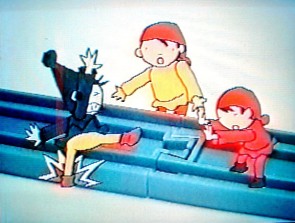From the point of view of sourcing buildings and other scenic details, it doesn't really matter what gauge the track is.
What matters is that the stuff looks correct in proportion to the trains. I suggest that a good measure would be the height of the engines and carriages from the bottoms of the wheels to the tops of the roofs, which is 50mm (if I remember correctly, as I'm currently 100 miles away from any). British railway stock Loading Gauge was (and is) infinitely variable, but an average height published in a 1930's carriage and wagon builders pocket book was 12 feet 10 inches, which can conveniently be approximated to 4 meters, so if 50mm = 4m then the scale is 50:4000 = 1:80
S Scale = 1:64
OO Scale = 1:76
HO Scale = 1:87
So any buildings designed for OO/HO railways OUGHT to look OK.
Of course if I've remembered 50mm incorrectly, then this is all nonsense. Would someone like to check please?
What matters is that the stuff looks correct in proportion to the trains. I suggest that a good measure would be the height of the engines and carriages from the bottoms of the wheels to the tops of the roofs, which is 50mm (if I remember correctly, as I'm currently 100 miles away from any). British railway stock Loading Gauge was (and is) infinitely variable, but an average height published in a 1930's carriage and wagon builders pocket book was 12 feet 10 inches, which can conveniently be approximated to 4 meters, so if 50mm = 4m then the scale is 50:4000 = 1:80
S Scale = 1:64
OO Scale = 1:76
HO Scale = 1:87
So any buildings designed for OO/HO railways OUGHT to look OK.
Of course if I've remembered 50mm incorrectly, then this is all nonsense. Would someone like to check please?


![[-]](https://www.blueplastictracks.org/images/collapse.png)